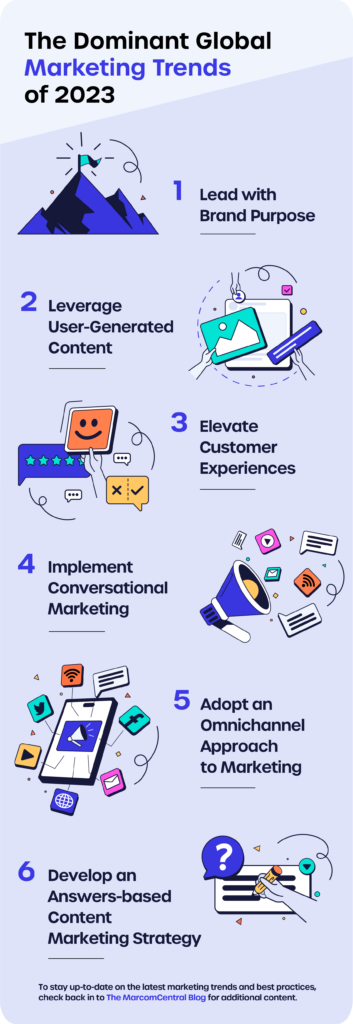- Table of Contents:
- 1). Lead with Brand Purpose
- 2). Leverage User-Generated Content
- 3). Elevate Customer Experiences
- 4). Implement Conversational Marketing
- 5). Adopt an Omnichannel Approach to Marketing
- 6). Develop an Answers-based Content Marketing Strategy
Get news, updates, and insights delivered straight to your inbox.
The Dominant Global Marketing Trends of 2023

The world around us continues to change rapidly and drastically. With this change comes new and exciting opportunities for brands to connect with their customers. Global marketing teams are bracing for leaner budgets going into 2023. Advertising forecast growth is expected to slow from 8.3% in 2022 to just 2.6% in 2023.
As budgets are tightening, marketing teams everywhere are finding that they need to optimize the campaigns that they can run and ensure that every dollar spent can make the most impact. This is especially difficult when the world continues to change so drastically, and news is volatile. When it comes to 2023 global marketing trends, these six represent some of the most innovative and dominating examples poised to make a major impact this year and beyond.

1). Lead with Brand Purpose
These days, consumers are pickier than ever when it comes to choosing what brands they do business with. Much of that is due to market saturation, an abundance of choice, and the expansion of digital marketing that allows people to connect with brands well outside their geographic area. One of the best ways a brand can stand out from this crowded pack is to develop and lead with a strong, confident brand purpose that is authentic, mission-forward, and values-centric.
A clear, powerful mission statement serves as the foundation for every brand. It governs how a brand positions itself to its audience and customers and thus shapes brand equity, or the public’s perceived valuation of the brand. An example of this is investing time into corporate social responsibility (CSR), where businesses contribute to broader societal causes. LEGO is one brand that tackles CSR with aplomb. By partnering with the World Wildlife Fund, LEGO has committed to reducing its overall carbon footprint and is working toward 100% renewable energy by 2030. By leaning into eco-friendly practices, LEGO’s brand purpose is defined by sustainability and helps it win huge favor among consumers who care deeply about environmental causes.
2). Leverage User-Generated Content
Brands don’t have to overextend themselves and produce all of their marketing collateral and content on their own. A great way to lighten the workload on marketing teams while highlighting customers is to leverage user-generated content (UGC). UGC is more authentic and trustworthy because it comes from a brand’s customers and advocates. In fact, 90% of users trust UGC to inform their purchasing decisions.
By tapping into UGC, brands can effectively start to shape brand perception and sentiment by highlighting content from invested, loyal customers. This sort of content is also highly effective at boosting user engagement and interaction, especially on social media, while driving increased conversions and revenue—ads with UGC reap click-through rates five times greater than average. GoPro does a fantastic job of leveraging UGC photos and videos taken by its product users to highlight their features and quality in a way that feels less self-serving and promotional.
3). Elevate Customer Experiences
Brands will need to create amazing customer experiences in 2023 to ensure that they can continue to thrive in uncertain conditions. Customers today base their loyalty to a brand on the experience it provides more than anything else. Case in point: a whopping 86% of buyers are willing to pay more for a great customer experience.
Brands looking to elevate their customer experience should consider the thoughtful application of technologies such as AI, machine learning, and augmented/virtual reality. These technologies make the customer experience more efficient and open new opportunities for customers to interact and engage with brands. For example, Nordstrom recently opened a new flagship store in New York that includes an experience called “Beauty Stylist Virtual Mirror” which allows shoppers to “try” out makeup trends facilitated by AR technology before buying products. Tactics like these, centered around revolutionizing a typical in-store customer experience, go a long way in a highly competitive industry like retail which is struggling to attract foot traffic.
4). Implement Conversational Marketing
In general, the dominating marketing trends today are those that are highly focused on brands adopting a more conversational and personal tone. This is what’s better known as conversational marketing, which strives to establish a one-on-one, real-time connection between customers and those marketing to them. The goal of conversational marketing is to enhance customer interaction and experience by providing instant solutions, resulting in higher levels of customer loyalty and satisfaction.
Adopting this more conversational, approachable tone in their marketing efforts has paid off for finance software company Ellie Mae. By employing bots designed to facilitate conversational marketing, they increased their daily demo requests by 165%. These were leads that had never gone to the trouble of filling out a demo request form until they were presented with an alternative that was more direct, human, and instantaneous regarding their needs.
5). Adopt an Omnichannel Approach to Marketing
In the past, Marketers have focused on single or complimentary channels when deciding on approaches to gain new customers. Omnichannel Marketing is a somewhat new shift that will continue to gain traction in 2023.
Omnichannel marketing is keeping a consistent brand experience across any channel a customer could interact with your brand. This means not just tracking what sort of feedback customers give in specific channels, but also bringing unified campaigns and messaging to potential prospects. These strategies help to give the power back to the customer and could be things like purchasing via Facebook messenger and picking up in-store, or identifying opinions of software posted on a message board and making changes in the product.
The marketing teams that allow customers and prospects more freedom on where they interact with the brand will be winners in 2023.
6). Develop an Answers-based Content Marketing Strategy
Lastly, brands should consider developing an answers-based content marketing strategy in 2023, rather than a traditional knowledge and promotional-based content strategy. The impetus for this is that last year, zero-click searches accounted for more than half of all Google search queries. This means that when users search for something in Google, a majority didn’t click on anything after executing their search to get what they were looking for.
Brands need to develop content that directly answers a query without searchers necessarily having to click on a link to find it. This is due to the rise of more platforms incentivizing native content. Google no longer requires clicks via features snippets, and social media networks are showcasing more content that keeps eyes on their social networks. Brands who are focused on creating amazing, and memorable content in the channels where customers live will see better returns in the long term.
To stay up-to-date on the latest marketing trends and best practices, check back in to The MarcomCentral Blog for additional content.


